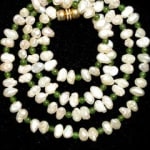Necklace Of Freshwater Pearls And Jade Beads
Freshwater Pearls
FB.0157
In Matthew, the kingdom of heaven is compared to a single rare and costly pearl for which a man would sell all he has. The delicate, lustrous beauty of the...
In Matthew, the kingdom of heaven is compared to a single rare and costly pearl for which a man would sell all he has. The delicate, lustrous beauty of the pearl has captured the imagination of men and women since the dawn of time. Early cultures worshiped it as a symbol of the moon goddess, a token of perfection. This exquisite gem is formed when an irritant becomes trapped inside the shell of a mollusk, most often an oyster. To protect itself, the animal forms a coating of nacre around the intrusive object, and this eventually may become a pearl. The gem ranges in color from pale white, to rosy pink, to gray or black. In the classical world, the finest pearls came from the Persian Gulf and the Indian Ocean, sometimes traveling for years to reach the palaces of Greece and Rome. Cleopatra, the queen of Egypt, is said to have dissolved an enormous pearl in wine, which she then drank to impress her lover Marc Antony with her extravagance. In the courts of Renaissance Europe, status was often measured through the size and beauty of one's pearls. Over thousands of years, pearls are one of the few jewelry items to remain continuously in fashion. It is easy to see why. They delight the eye and flatter the wearer, a true gift from nature.
The name jade is applied to two distinct minerals. Nephrite and jadeite, both extremely hard and usually green in color. In its purest and rarest form, jade is white, but it can range in hue from bright emerald green (called imperial jade), to spinach green to yellow, blue, black or mottled. Jade was prized in the Pre-Columbian world, where it was used for ceremonial objects, but enjoys its greatest popularity in the orient. There it is worked for objets-de-vertu, jewelry and amulets. Jade is valued as a good luck charm, and is believed to relieve physical ailments relating to the heart and kidneys. Its popularity continues to grow today in both east and west.
The name jade is applied to two distinct minerals. Nephrite and jadeite, both extremely hard and usually green in color. In its purest and rarest form, jade is white, but it can range in hue from bright emerald green (called imperial jade), to spinach green to yellow, blue, black or mottled. Jade was prized in the Pre-Columbian world, where it was used for ceremonial objects, but enjoys its greatest popularity in the orient. There it is worked for objets-de-vertu, jewelry and amulets. Jade is valued as a good luck charm, and is believed to relieve physical ailments relating to the heart and kidneys. Its popularity continues to grow today in both east and west.



